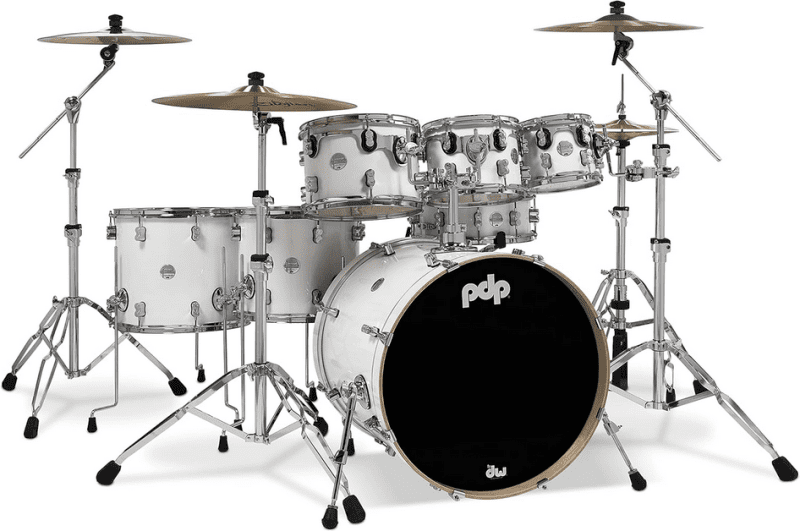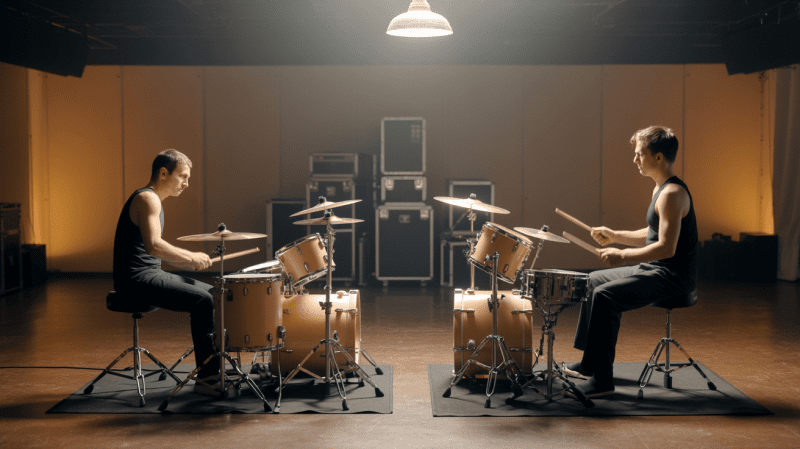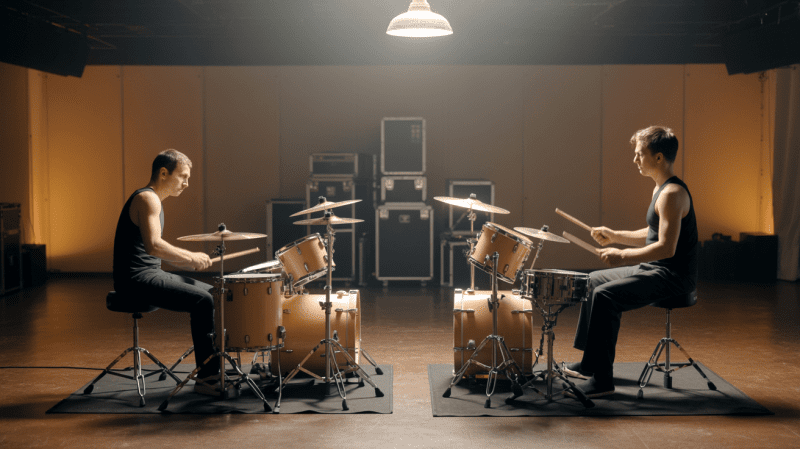"From Spare Room to Soundstage: Crafting Your Home Drumming Studio"

Building your dream drumming space at home can seem like a daunting task. With the right guidance, transforming any room into a personal studio is within reach. This article offers step-by-step instructions to create an acoustic haven for your drumming passion, neatly mixing practicality with creativity.
Dive in and discover how to hit the right note in your very own drumming studio!
Key Takeaways
- Choose a room with solid walls and few windows for better soundproofing using materials like acoustic panels, bass traps, and diffusers.
- Pick the right equipment such as a quality drum set, comfortable drumsticks, sturdy hardware, audio interface for recording, drums-specific microphones, a mixer, studio monitors, headphones,
- Set up your studio by planning the layout carefully and including sound absorption flooring like carpets; ensure good lighting; select motivating color schemes; manage temperature with HVAC or fans; keep humidity in check to protect gear; organize with storage solutions.
- Enhance your experience by adding ergonomic seating that supports posture during long sessions. Integrate inspiring artwork or posters in the space. Maintain clear visibility without glare from well-placed lights. Use dehumidifiers if needed to safeguard instruments.
- Consider climate control via an HVAC system to maintain comfort levels. Store items neatly with shelving units or instrument cases. Stay prepared to record at any time by having microphones ready to use and embrace technology through Wi-Fi connectivity for collaborating online or accessing tutorials.
Factors to Consider When Building a Home Drumming Studio

Creating your own drumming oasis means mulling over more than just where to stash your snare; it's about curating an environment that resonates with rhythm while respecting the peace.
You'll need to tune in to details such as acoustics, gear selection, and room design—all of which play pivotal roles in bringing out the best beats from your basement or bedroom studio.
Soundproofing Solutions
Drumming at home can be loud, and you don't want to disturb others. Good soundproofing solutions keep the beat without complaints. First, think about adding acoustic panels to your walls.
These help absorb sound and reduce noise leakage.
Another nifty trick is to set up bass traps in room corners where low frequencies gather. Don't forget diffusers; they scatter sound waves, making your studio acoustics even better.
Companies like DRUM Percussion Studio specialize in such gear, so you'll know it's made for drummers like you!
Equipment Selection
Choosing the right equipment can make or break your drumming studio. Start with a quality drum set that fits your space and style. Add cymbals for variety, but don't go overboard – select what you'll actually use.
Make sure you have sturdy drum hardware and comfortable drumsticks; they're essential for practice sessions.
Don’t forget about recording gear if you plan to capture your beats. A reliable audio interface, microphones tailored to drums, a mixer for sound levels, studio monitors for playback, and headphones for detailed listening are all key.
Think about ergonomics too; find a drum throne that supports long playing hours without back pain.
Fill out your home studio with technological tools like a DAW for producing music and MIDI controllers if you’re blending electronic elements into your work. If Pirate Studios’ options inspire you, integrate similar equipment selections they offer in their rental spaces.
Your setup should also consider power needs – ample outlets and surge protection keep things safe. With the right mix of instruments, tech-savvy features, ergonomic furniture and solid electrical infrastructure, you're ready to hit the ground running—or rather—the drums booming!
Step-by-step Guide to Constructing a Home Drumming Studio

Building your own drumming studio at home lets you practice anytime. Here's how to create a space that sounds great and feels inspiring.
- Pick the right room. Choose a space with few windows and solid walls for better sound control.
- Plan the layout. Arrange your drum set, recording gear, and seating to allow easy movement and comfort.
- Soundproof the space. Use acoustic treatments like foam panels or build DIY acoustic panels to absorb sound.
- Improve the room design with the right flooring. Carpets can reduce bounce and enhance acoustics.
- Focus on lighting. Install bright lights for energy or softer lights for a relaxed vibe, depending on your preference.
- Choose a color scheme that motivates you. Colors can affect your mood; select tones that keep you energized.
- Ensure an ergonomic setup for your equipment so playing for long hours doesn't strain your body.
- Install an HVAC system or use fans to control air circulation and temperature in the room.
- Manage humidity levels to protect your drums and equipment from damage due to moisture.
- Create storage solutions like shelving units or cases to organize drum gear when not in use.
- Handle power needs safely. Have enough power outlets and ensure wiring is secure to prevent accidents.
- Integrate technology such as a DAW or electronic drum options for advanced recording capabilities.
- Include comfortable furniture like chairs or music stands; consider adding a lounge area if space allows it.
- Secure the studio with locks or surveillance systems to keep your instruments safe when you're away.
- Set up networking with Wi-Fi connectivity for online collaborations or learning new skills from tutorials.
- Build something yourself! Try making custom storage solutions or even constructing a drum riser if you're handy.
Tips to Enhance Your Drumming Studio Experience
Now that your drumming studio is set up, let's focus on making the most of it. Keep your space comfortable by adding seating for breaks and guests. Choose chairs that support good posture while playing.
Hang some inspiring posters or artwork to fuel creativity during sessions. Good lighting is also key – make sure you can see your equipment clearly without harsh glares.
Next, consider the climate in your studio because temperature and humidity affect both comfort and instruments. An HVAC system helps control the environment, keeping it just right for drumming.
Add a dehumidifier if moisture levels are high to protect your drums from warping or damage.
Storage solutions keep everything organized so you can find sticks, sheet music, and cables quickly. Use instrument cases to safeguard gear when not in use. Make room for recording gear too – having microphones set up means you're always ready to capture a great beat.
Finally, stay connected with technology integration like Wi-Fi setup and cable management for smooth recording sessions using DAWs or drum triggering systems. It's all about creating a space where you can focus on what matters: playing the drums!
Conclusion
Building your own drumming studio at home is a big project. You'll need to think about soundproofing, equipment, and room design. Let's talk with an expert for the best advice.
Meet Jamie Carter, a seasoned sound engineer with over 20 years in music production. He studied audio engineering and has worked on many home studios. His work helps musicians create perfect recording spaces.
Jamie says good soundproofing is key for a drumming studio at home. It keeps the noise down for others and gives you better sound quality inside. Using the right materials can make a difference.
Safety matters too when building your own space. Jamie reminds us that using fire-resistant materials is smart. Also, being open about what you're using helps if you ever need insurance or permits.
Your new studio should fit into your life well according to Jamie. Think about where it goes in your house and how often you'll use it. Make sure there's enough storage for all your gear too.
Every choice has pros and cons though, as Jamie points out:
**Pros:**
- Fun to play whenever you want
- Can improve skills faster
- Saves money long-term compared to renting
**Cons:**
- Upfront costs can be high
- Takes time to set everything up
- Your neighbors might not like the noise
In comparison with other options like renting space or playing at friend's houses, having your own studio gives more freedom but takes more work.
Finally, Jamie believes a home drumming studio offers great value for serious drummers but advises thorough planning before starting this project.
FAQs
1. What do I need to soundproof my home drumming studio?
To keep the peace with your neighbors, you'll want acoustic treatment for soundproofing – like building acoustic panels or other DIY soundproofing tips.
2. Can I set up my recording gear by myself?
Absolutely! Just grab a good microphone and maybe a digital audio workstation (DAW). Follow online tutorials for layout planning, and start laying down some beats!
3. How important is room design in a drumming studio?
Room design is super important – it can make playing easier and improve your sound. Think about where everything should go, from your drum set to seating arrangements.
4. Why should I worry about ventilation in my drum studio?
Drums can get pretty hot! It's smart to have HVAC systems in place so you can control temperature and humidity — this keeps both you and your equipment happy.
5. Do I need special insurance for my home drumming studio?
Yes, definitely look into getting insurance — accidents happen! Plus, check out locks or access control options to keep your gears safe.
6. Should I think about power outlets when setting up my studio?
You bet; drums might not need power but recording gear does! Make sure you've got enough power outlets around, and always remember electrical safety.
Recent Related Articles:
Sound Proof Your Basement for Your Band - Ultimate Guide



